
Danaus genutia, the common tiger, is one of the common butterflies of India. It belongs to the "crows and tigers", that is, the Danainae group of the brush-footed butterflies family. The butterfly is also called striped tiger in India to differentiate it from the equally common plain tiger, Danaus chrysippus. The species was first described by Pieter Cramer in 1779.

Mycalesis oculus, the red-disc bushbrown, is a satyrine butterfly found in southern India. It is similar in markings to Mycalesis adolphei but distinguished by the reddish band around the large apical spots on the upper forewings.
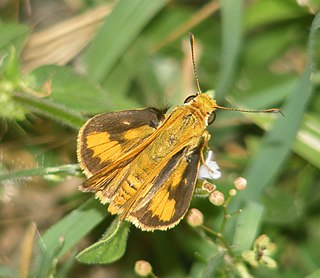
Telicota colon, commonly known as the pale palm dart or common palm dart, is a species of butterfly in the family Hesperiidae. It is found from India to Australia.

Papilio clytia, the common mime, is a swallowtail butterfly found in south and southeast Asia. The butterfly belongs to the subgenus Chilasa, the black-bodied swallowtails. It serves as an excellent example of a Batesian mimic among the Indian butterflies.

Cethosia cyane, the leopard lacewing, is a species of heliconiine butterfly found from India to southern China, and Indochina. Its range has expanded in the last few decades, and its arrival in the southern part of the Malay Peninsula, including Singapore, is relatively recent.

Chilades parrhasius, the small Cupid, is a small butterfly that belongs to the lycaenids or blues family. It is found in Nepal, southern Turan, southern Ghissar, Iran, Afghanistan, Pakistan, Sri Lanka, United Arab Emirates, Oman and southern, central and north-west India.

Curetis bulis, the bright sunbeam, is a species of butterfly belonging to the lycaenid family. It is found in Asia.

Cethosia nietneri, the Tamil lacewing, is a species of nymphalid butterfly found in Sri Lanka and south India. The species name is after John Nietner who obtained specimens of the butterfly from Ceylon from which it was described.
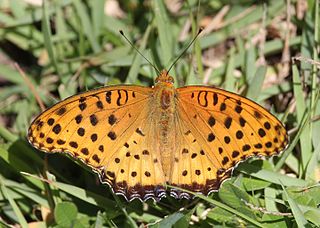
The Indian fritillary is a species of butterfly of the nymphalid or brush-footed family. It is usually found from south and southeast Asia to Australia.

Pratapa deva, the white royal, is a lycaenid or blue butterfly found in the Indomalayan realm. The species was first described by Frederic Moore in 1857.
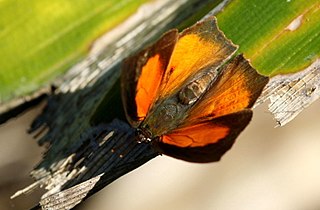
Curetis acuta, the angled sunbeam, is a species of butterfly belonging to the lycaenid family. It is found in Indomalayan realm. Curetis acuta is sexually dimorphic, the sexes differing in dorsal coloration of the wings, however their ventral wings are similar and of silver color which reflects sunlight. The reflection of light by silver ventral wings plays a role of signalling during flight, camouflage while at rest or during hibernation, and lowering body temperatures by reflecting the sunlight.

Erebia ligea, the Arran brown, is a member of the subfamily Satyrinae of the family Nymphalidae. This brown is widespread in south-eastern and northern Europe. It prefers mixed woodlands at low altitudes. It is rarely seen in open areas. This species was first described by Carl Linnaeus in his 1758 10th edition of Systema Naturae, and the type locality is Sweden.
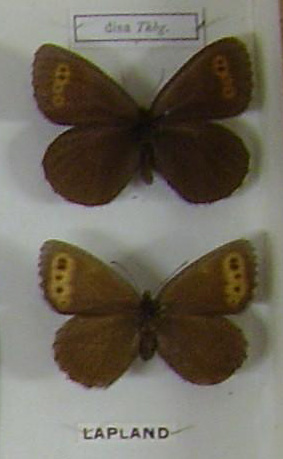
The Arctic ringlet or Disa alpine is a member of the subfamily Satyrinae of family Nymphalidae. It is associated with wet muskeg and bogs in subarctic and Arctic climates, and is often found near the tree-line. The larva overwinters twice before undergoing metamorphosis into an adult. It is found in Arctic Europe, Arctic European Russia, Sajan, Irkutsk, Yakutsk, Yablonoi and Arctic North America.

Cethosia biblis, the lacewing biblis or red lacewing, is a species of heliconiine butterfly belonging to the family Nymphalidae.

Polyommatus amandus, the Amanda's blue, is a butterfly of the family Lycaenidae. It is found in the Palearctic realm.
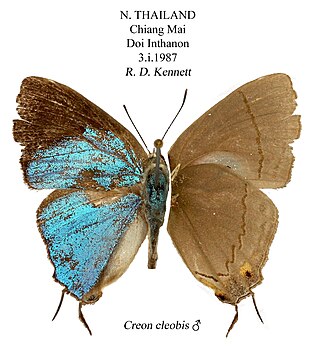
The broadtail royal is a butterfly in the monotypic genus Creon, in the family Lycaenidae. It is found in South Asia.

Chlosyne lacinia, the bordered patch or sunflower patch, is a North and South American butterfly in the family Nymphalidae.

Cethosia, commonly called the lacewings, is a genus of butterflies of the subfamily Heliconiinae in the family Nymphalidae. They are found mainly in southeastern Asia as far south as Australia.

Cethosia hypsea, the Malay lacewing, is a butterfly of the family Nymphalidae. It is found in from Myanmar to Indonesia and the Philippines.
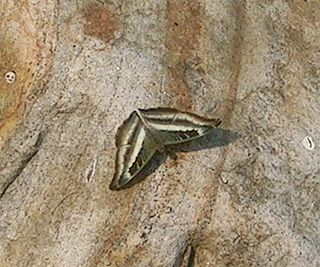
Auzakia is a monotypic butterfly genus in the family Nymphalidae. It contains the single species, Auzakia danava, the commodore, which is found from Tibet to Sumatra.





















